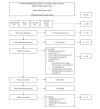Smart Devices for Older Adults Managing Chronic Disease: A Scoping Review
- PMID: 28536089
- PMCID: PMC5461419
- DOI: 10.2196/mhealth.7141
Smart Devices for Older Adults Managing Chronic Disease: A Scoping Review
Abstract
Background: The emergence of smartphones and tablets featuring vastly advancing functionalities (eg, sensors, computing power, interactivity) has transformed the way mHealth interventions support chronic disease management for older adults. Baby boomers have begun to widely adopt smart devices and have expressed their desire to incorporate technologies into their chronic care. Although smart devices are actively used in research, little is known about the extent, characteristics, and range of smart device-based interventions.
Objective: We conducted a scoping review to (1) understand the nature, extent, and range of smart device-based research activities, (2) identify the limitations of the current research and knowledge gap, and (3) recommend future research directions.
Methods: We used the Arksey and O'Malley framework to conduct a scoping review. We identified relevant studies from MEDLINE, Embase, CINAHL, and Web of Science databases using search terms related to mobile health, chronic disease, and older adults. Selected studies used smart devices, sampled older adults, and were published in 2010 or after. The exclusion criteria were sole reliance on text messaging (short message service, SMS) or interactive voice response, validation of an electronic version of a questionnaire, postoperative monitoring, and evaluation of usability. We reviewed references. We charted quantitative data and analyzed qualitative studies using thematic synthesis. To collate and summarize the data, we used the chronic care model.
Results: A total of 51 articles met the eligibility criteria. Research activity increased steeply in 2014 (17/51, 33%) and preexperimental design predominated (16/50, 32%). Diabetes (16/46, 35%) and heart failure management (9/46, 20%) were most frequently studied. We identified diversity and heterogeneity in the collection of biometrics and patient-reported outcome measures within and between chronic diseases. Across studies, we found 8 self-management supporting strategies and 4 distinct communication channels for supporting the decision-making process. In particular, self-monitoring (38/40, 95%), automated feedback (15/40, 38%), and patient education (13/40, 38%) were commonly used as self-management support strategies. Of the 23 studies that implemented decision support strategies, clinical decision making was delegated to patients in 10 studies (43%). The impact on patient outcomes was consistent with studies that used cellular phones. Patients with heart failure and asthma reported improved quality of life. Qualitative analysis yielded 2 themes of facilitating technology adoption for older adults and 3 themes of barriers.
Conclusions: Limitations of current research included a lack of gerontological focus, dominance of preexperimental design, narrow research scope, inadequate support for participants, and insufficient evidence for clinical outcome. Recommendations for future research include generating evidence for smart device-based programs, using patient-generated data for advanced data mining techniques, validating patient decision support systems, and expanding mHealth practice through innovative technologies.
Keywords: chronic disease; chronic disease management; mHealth; mobile health; mobile phone; older adults; scoping review; seniors; smartphone; tablet.
©Ben YB Kim, Joon Lee. Originally published in JMIR Mhealth and Uhealth (http://mhealth.jmir.org), 23.05.2017.
Conflict of interest statement
Conflicts of Interest: None declared.
Figures
References
-
- Akter S, Ray P. mHealth - an ultimate platform to serve the unserved. Yearb Med Inform. 2010:94–100. - PubMed
-
- Free C, Phillips G, Galli L, Watson L, Felix L, Edwards P, Patel V, Haines A. The effectiveness of mobile-health technology-based health behaviour change or disease management interventions for health care consumers: a systematic review. PLoS Med. 2013;10(1):e1001362. doi: 10.1371/journal.pmed.1001362. http://dx.plos.org/10.1371/journal.pmed.1001362 - DOI - DOI - PMC - PubMed
-
- Kay Misha, Jonathan Santos, Marina Takane. mHealth: new horizons for health through mobile technologies. Geneva, Switzerland: World Health Organization; 2011. Jun, [2011-12-08]. http://www.who.int/goe/publications/goe_mhealth_web.pdf .
-
- Cole-Lewis H, Kershaw T. Text messaging as a tool for behavior change in disease prevention and management. Epidemiol Rev. 2010;32:56–69. doi: 10.1093/epirev/mxq004. http://europepmc.org/abstract/MED/20354039 - DOI - PMC - PubMed
Publication types
LinkOut - more resources
Full Text Sources
Other Literature Sources
Miscellaneous



